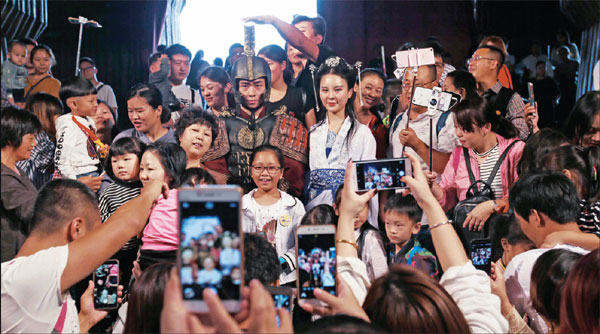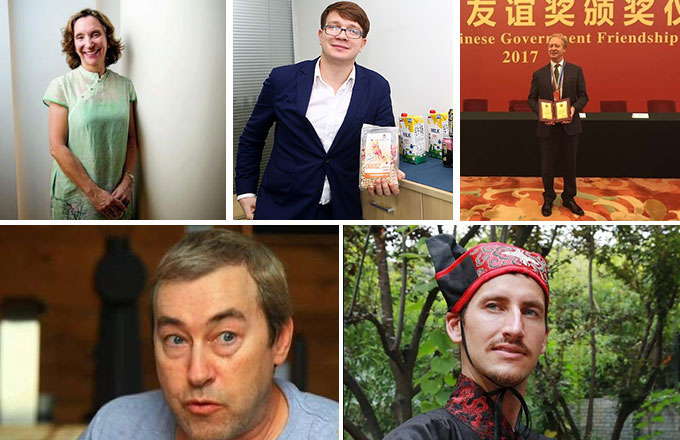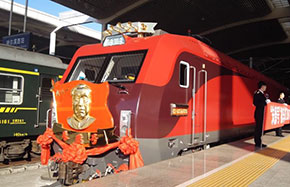Dream factory
More than just a film lot, the vast Hengdian World Studios embodies the history of China
On a sweltering, overcast afternoon, an old bus from Yiwu city is bouncing along the narrow mountain road toward the town of Hengdian, Zhejiang province, its windows covered with translucent blue paper. Inside, it is gloomy and smells of gasoline, but no one is complaining: The passengers are looking forward to spotting celebrities.
One woman, discussing actress Zhao Liying (The Journey of Flower, Princess Agents), says: "I am sure she is in Guangzhou Street. We can definitely see her there tomorrow."
Her friend has a different opinion: "The show she is filming is set in the Song Dynasty (960-1279), so they must be in the Riverside Scene at Qingming Festival."
|
Tourists take photos with staff in costume at the gate of the Palace of Emperor Qin. Photos Provided by The World of Chinese |
We are heading for Hengdian World Studios, the largest outdoor film lot in the world. It's one of China's biggest attractions, pulling in more than 100 million tourists since it opened in 1996.
Western media sometimes call it "Chinawood", while Chinese prefer the nickname "Great Heng Kingdom" (大横国 dàhéngguó). Few in the industry have not paid a visit to its iconic sets, including a gleaming replica of the Forbidden City in Beijing, the Palace of Emperor Qin in Shaanxi, the former Northern Song capital of Kaifeng and the streets of colonialera Hong Kong and Canton (now Guangzhou). Together, they supply a historical background of some 2,000 years, from the Qin Dynasty (221-206 BC) to the Republic of China, for potential producers. For tourists, a stroll around Hengdian is a journey through time; nowhere else in China can one see so many "historical" sites assembled in a single place.
Others come for a different sight. According to the South China Morning Post, 20 percent of all Chinese films and TV series are filmed here, and the town has played host to more than 1,800 productions in the past two decades, making Hengdian a pilgrimage spot for those happy to pay hundreds of renminbi to glimpse their favorite star.
When the bus arrives, though, it's dark, with few people on the street. I look around, only to see a few dim streetlights. Chinawood has no Sunset Strip or Rodeo Drive, no VIP nightclubs or swanky restaurants. In fact, it barely has any nightlife at all. It's hard to believe there are superstars somewhere in this low-profile town. But boring as it may be, filmmakers relish Hengdian's opportunity for one-stop-shop continuous shoots.
Next morning, I start with Guangzhou and Hong Kong Street, because it is here that the Hengdian story began. In 1995, famous director Xie Jin was scouting locations for The Opium War, but couldn't find anywhere suitable for shooting 19th-century street scenes. Hearing this, Xu Wenrong, founder of electronics company the Hengdian Group, came to Xie and volunteered to build a site from scratch. It was this outlandish proposal that changed the fate of this small town, located hours from the nearest major city, and with no rail or air connection at the time.
Xu found himself with an order for 100 Qing-style houses, a tower and an imitation Zhujiang River within three months. It sounded almost impossible, but Xu agreed. According to an autobiography published in 2011, Xu assigned the project to 120 work teams, building around the clock.
Today, there are complete replicas of street scenes from the 19th century: European-style two-story mansions, the Hong Kong and Shanghai Bank, an old-fashioned theater and ballrooms a few steps away from Chinese-style restaurants, the imperial examination hall and obsolete temples.
The site is smaller than one might imagine, however, and the layout is strange, with the buildings distributed in a way that would be irrational in a real town.
Hengdian draws thousands of movie set extras each year, some looking for background work, others hoping for a big break. It's common to see groups of young migrants in areas such as the Street of Great Knowledge, hanging around, killing time. With the right look, a good extra can make over $100 (84 euros; £74) a day, and only work half the year. But most feel the need to stay in town year-round, working assorted gigs with casting directors and photography studios; plenty more give up and drift away from Hengdian, in search of new roles in life.
A tour bus takes just a few minutes to deposit me at the Palace of Emperor Qin, the original of which is supposed to lie in ruins in Shaanxi province. In Hengdian, though, the Qin Emperor's glories are very much intact, and the gates of China's first imperial palace are besieged with tourists rather than barbarians.
Usually, most stories set before the Tang Dynasty can be filmed in the Palace of Emperor Qin. But when it comes to the next dynasty, the Song, the studio has another site especially for it - Riverside Scene at Qingming Festival, named after the famous painting of the same name by Song artist Zhang Zeduan. Considered the most renowned work among all Chinese paintings, it depicts in detail the street scenes and people's daily life in Bianliang, currently Kaifeng, Henan province. Here in Hengdian, everything from the iconic painting has become three-dimensional: Song-style houses, stone paths, small bridges, glassy water, gaily-painted boats and pavilions situated in the center of the lake.
The difference is that here, and unlike the Qin palace, everything looks artificial and miniature. Having seen how simple and crude these sets are, the importance of cinematography and post-production becomes immediately evident. Indeed, many of these lots may themselves become largely redundant in the future, as technology and special effects take an increasingly important role in filmmaking.
But with so much of Hengdian's work coming from multitudes of lowbudget, cookie-cutter productions, that day is still some way off. And many of the sets are stunning: The best part of Riverside Scene at Qingming Festival is the Fan Restaurant, a replica of the popular Song diner. According to the original structure described in Reminiscences of the Eastern Capital (《东京梦华录》), the Fan Restaurant has three floors and five branch buildings, all decorated with multiple lanterns. The path in front of its gate stretches to the bridge over the river.
The last stop of my tour is the Palace of the Ming and Qing Dynasties, the largest scenic area of the studio, and more popularly known to foreigners as the Forbidden City, built in 1998 to a 1:1 ratio - only the Tian'anmen Rostrum was shrunk by 20 percent. The total area is about 1 million square meters, or twice the size of the Palace of Emperor Qin.
All told, though, it doesn't matter whether the buildings are authentic or fake, the layouts reasonable or haphazard. No one ever expects the real Forbidden City. For some tourists, visiting Hengdian is more like a ritual, to stand on their own feet in this dreamland where their favorite movies are born, to take a breath of the same air that their beloved characters once inhaled.
Courtesy of The World of Chinese; www.theworldofchinese.com.cn
The World of Chinese



















